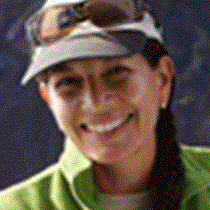Bartolomé & Rabida Islands
Early in the morning we found ourselves at Bartolomé Island, named after Bartholomew Sullivan, 2nd lieutenant on the HMS Beagle. Bartolomé is a lovely volcanic islet just off the east coast of Santiago Island.
We set foot on Bartolomé just before breakfast and hiked among a volcanic moonscape of rust-colored "spatter cones," large pale tuff cones and sooty lava flows, where the action of erosion over time has created graceful features in the soft volcanic ash. Few plant species can withstand the drought conditions that occur here, but some survive quite well, such as the endemic lava cactus and the grey matplant.
Climbing a long wooden staircase of 399 steps to reach the summit of the island was a little bit challenging for some guests, but the view at the top was worth every breath — a scenic landscape mosaic with beaches made of gold sand bordered by green mangroves, black lava flows and turquoise waters.
After this vigorous walk we enjoyed breakfast before collecting our snorkeling gear for our first encounter with the Galápagos underwater world. From the beach we had plenty of time for swimming and snorkeling in the search of flitting penguins, as well colorful reef fish, rays and reef sharks.
Once all of us came back aboard, we weigh anchor immediately and started sailing west, towards Rabida Island (formerly known as Jervis), where we arrived mid-afternoon. Rabida was recently the focus of a successful campaign for the eradication of the destructive, introduced black rats. In 1975 the Galápagos National Park Service successfully eradicated introduced goats from this island, and this next step could restore the island to its original balanced ecosystem.
Rabida has one of the most unusual beaches. Sand made from lava with high iron oxide content has created a red beach where sea lions rest and welcome visitors every day. Snorkelling was possible along the rocky wall near the point but also kayaking was also possible for those who preferred to glimpse the life below the surface without submerging.
This is the world that Charles Darwin visited in 1835, and which shaped evolutionary science forever. We were part of it today!




